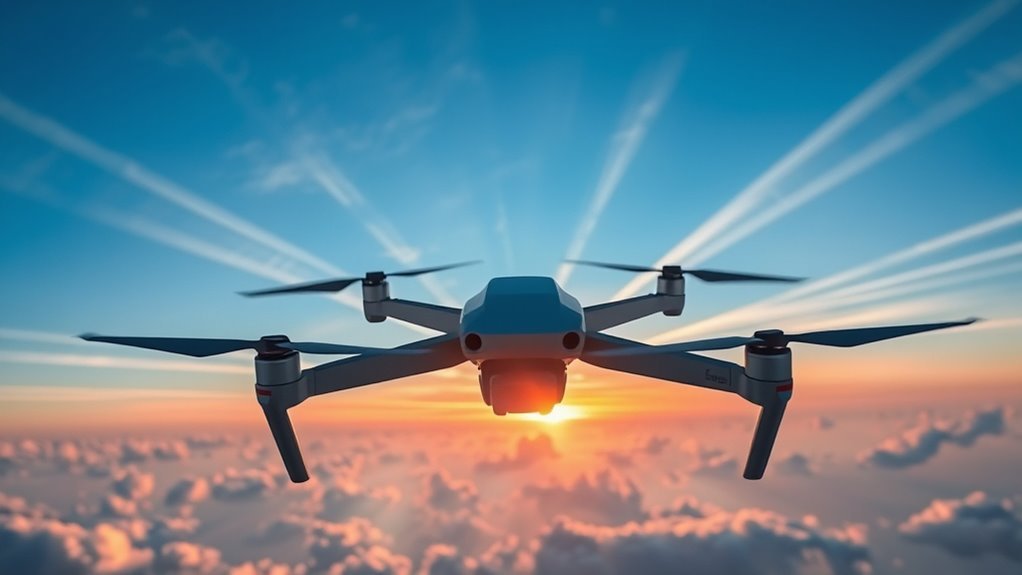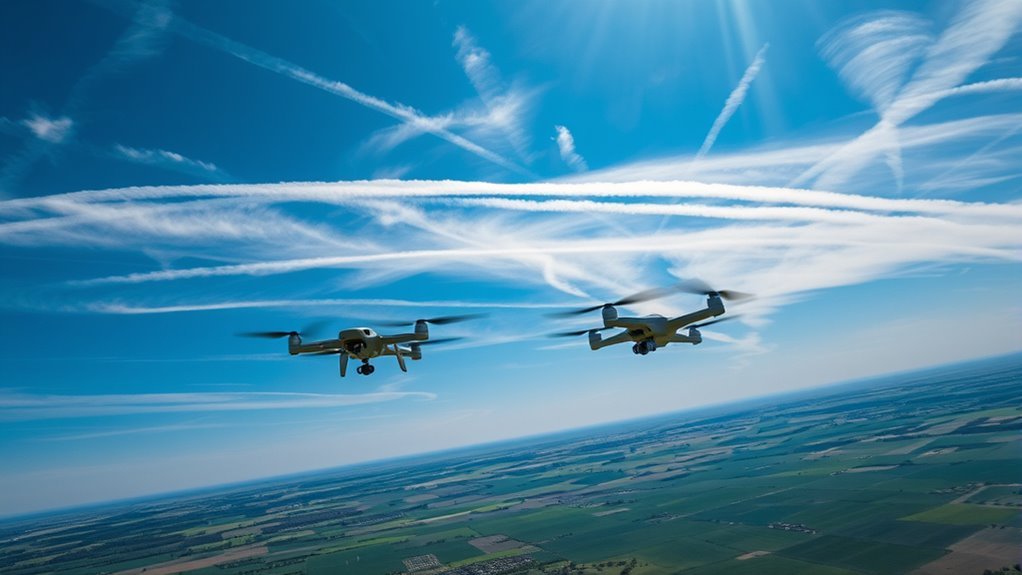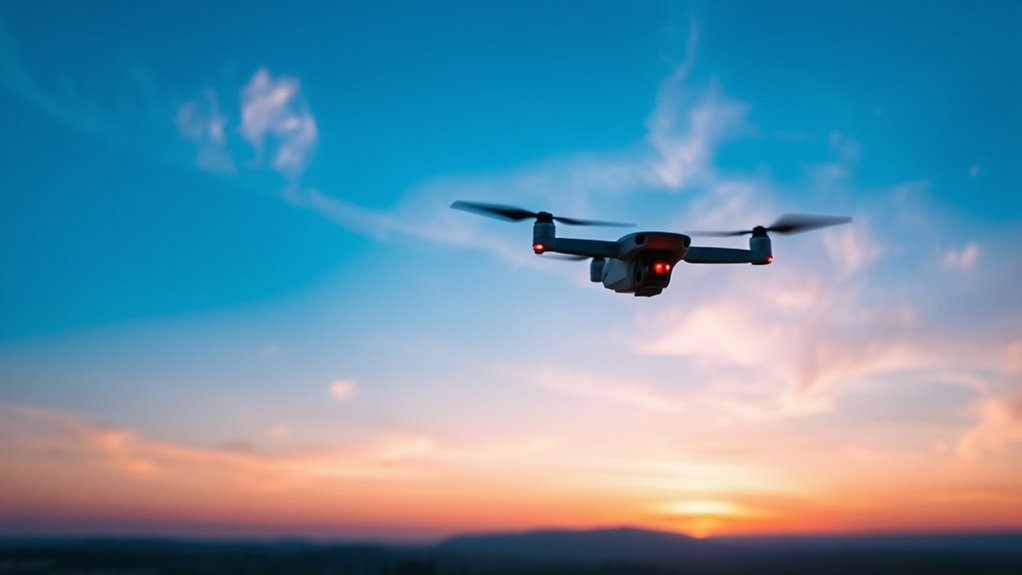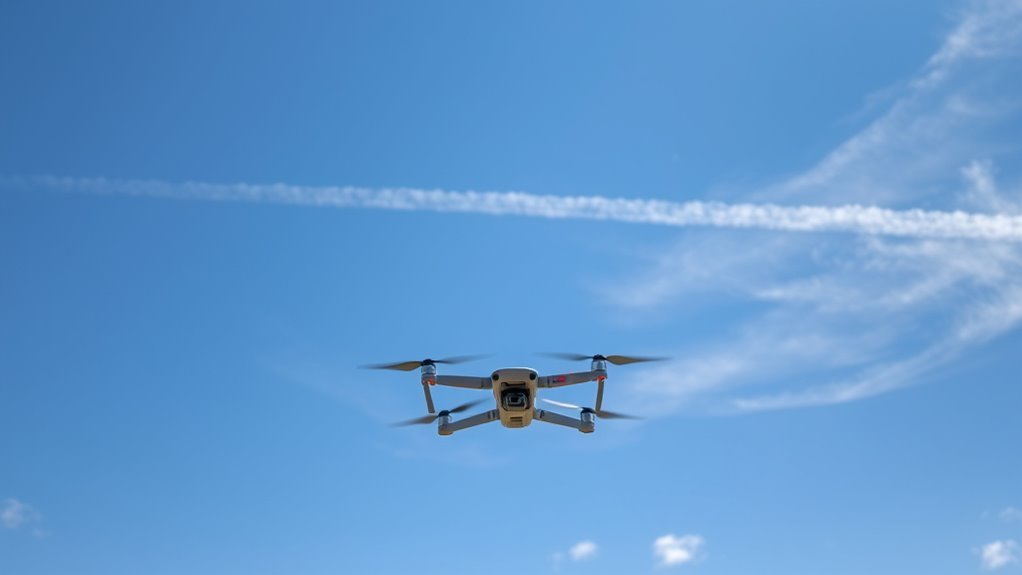You won’t see drones leaving contrails because they usually fly too low, often under 1,000 feet, where temperatures aren’t cold enough for contrail formation. Their engines, often electric or small combustion types, produce cooler exhaust lacking the moisture and heat needed to create ice crystal trails. Only specialized high-altitude drones with combustion engines might occasionally form contrails under specific conditions. Exploring these factors reveals why drones and traditional aircraft differ regarding contrail production.
What Are Contrails and How Do They Form?

Contrails, short for condensation trails, are line-shaped clouds produced by aircraft engine exhaust or changes in air pressure, typically at high altitudes. When hot, humid exhaust gases mix with the cold surrounding air, water vapor condenses into tiny ice crystals, forming visible trails. Contrail formation depends critically on atmospheric conditions like temperature, humidity, and pressure. You’ll find that in extremely cold, saturated air, contrails persist and spread; in drier or warmer conditions, they dissipate quickly. Understanding these factors is key if you want to grasp why some aircraft leave persistent contrails while others don’t. This knowledge empowers you to analyze flight activity and atmospheric interactions without assumptions, maintaining your freedom to interpret observations based on precise environmental science rather than speculation.
Altitude and Conditions Required for Contrail Formation

Although you might notice vapor trails behind many aircraft, the formation of contrails requires specific altitudes and atmospheric conditions. Contrails typically form at high altitudes, generally above 25,000 feet, where the ambient temperature conditions drop below approximately -40°C. This cold environment allows the water vapor in exhaust to rapidly condense and freeze, creating visible ice crystals. When considering drone altitude, most consumer and commercial drones operate well below this threshold, often under 1,000 feet, where temperature conditions are too warm and air pressure too high to support contrail formation. Consequently, unless a drone reaches unusually high altitudes with sufficiently low temperatures, you won’t see contrails. Understanding these precise altitude and temperature conditions helps clarify why contrails are common in traditional aviation but effectively absent in typical drone operations.
Differences Between Drones and Traditional Aircraft Engines

When you compare drones to traditional aircraft, one of the most significant differences lies in their engine types and exhaust characteristics. Drone engines are generally smaller, often electric or small combustion types, focusing on high fuel efficiency and reduced emissions. Traditional aircraft use large jet engines optimized for sustained high thrust, producing hotter, moisture-rich exhaust conducive to contrails. This distinction affects the likelihood of contrail formation.
| Feature | Drone Engines | Traditional Aircraft Engines |
|---|---|---|
| Engine Type | Electric / Small combustion | Turbofan / Turbojet |
| Fuel Efficiency | High, optimized for endurance | Moderate, optimized for power |
| Exhaust Temperature | Lower | High |
| Contrail Potential | Low due to cooler, cleaner exhaust | High due to hot, moist exhaust |
Understanding these differences clarifies why drones rarely produce contrails.
Can High-Altitude or Specialized Drones Produce Contrails?
How likely are high-altitude or specialized drones to produce contrails under specific atmospheric conditions? With advances in drone technology, some models now operate at altitudes comparable to commercial aircraft, where contrail physics become relevant. Contrails form when hot exhaust gases mix with cold, moist air, causing water vapor to condense and freeze. Since many drones use electric propulsion, they typically lack the high-temperature exhaust required for contrail formation. However, specialized drones powered by combustion engines at high altitudes could generate enough heat and water vapor to trigger contrails, especially in supersaturated layers. Understanding contrail formation in these drones demands precise analysis of engine type, altitude, ambient temperature, and humidity. So, while most drones won’t leave contrails, select high-altitude, combustion-powered drones might under the right atmospheric conditions.
Environmental Impact of Drone Flights Compared to Airplanes
While most drones don’t produce contrails due to their propulsion systems and operational altitudes, their environmental impact compared to traditional airplanes remains a key consideration. You’ll find that drone emissions are markedly lower because many drones use electric motors rather than combustion engines, reducing greenhouse gas outputs. Additionally, flight noise from drones is generally less intrusive, benefiting communities and wildlife sensitive to noise pollution. However, widespread drone usage could cumulatively increase energy demands and localized noise levels, necessitating careful regulation. Unlike airplanes, drones operate at lower altitudes, minimizing contrail formation but potentially affecting air quality closer to the ground. When evaluating freedom in flight, you must weigh these environmental factors alongside operational benefits, ensuring drone integration promotes sustainable, low-impact aerial mobility without replicating the ecological footprint of conventional aviation.

